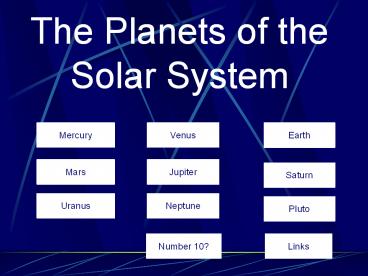The Planets of the Solar System - PowerPoint PPT Presentation
Title:
The Planets of the Solar System
Description:
Title: PowerPoint Presentation Author: Peter Morris Last modified by: Toni Created Date: 11/17/2003 5:40:59 PM Document presentation format: On-screen Show (4:3) – PowerPoint PPT presentation
Number of Views:973
Avg rating:3.0/5.0
Title: The Planets of the Solar System
1
The Planets of the Solar System
Venus
Mercury
Earth
Mars
Jupiter
Saturn
Uranus
Neptune
Pluto
Links
Number 10?
2
Mercury
Mercury is the closest planet to the Sun and the
eighth largest. Mercury is smaller in diameter
than Ganymede and Titan but more massive
In Roman mythology Mercury is the god of
commerce, travel and thievery, the Roman
counterpart of the Greek god Hermes, the
messenger of the Gods. The planet probably
received this name because it moves so quickly
across the sky.
Menu
3
Venus
Venus is the second planet from the Sun and the
sixth largest. Venus' orbit is the most nearly
circular of that of any planet, with an
eccentricity of less than 1.
Venus (Greek Aphrodite Babylonian Ishtar)
is the goddess of love and beauty. The planet is
so named probably because it is the brightest of
the planets known to the ancients. (With a few
exceptions, the surface features on Venus are
named for female figures.)
Menu
Space missions
4
Earth
Earth is the third planet from the Sun and the
fifth largest
Earth is the only planet whose English name does
not derive from Greek/Roman mythology. The name
derives from Old English and Germanic. There are,
of course, hundreds of other names for the planet
in other languages. In Roman Mythology, the
goddess of the Earth was Tellus - the fertile
soil (Greek Gaia, terra mater - Mother Earth).
Menu
The Moon
5
Mars
Mars is the fourth planet from the Sun and the
seventh largest
Mars (Greek Ares) is the god of War. The
planet probably got this name due to its red
color Mars is sometimes referred to as the Red
Planet. (An interesting side note the Roman god
Mars was a god of agriculture before becoming
associated with the Greek Ares those in favor of
colonizing and terraforming Mars may prefer this
symbolism.) The name of the month March derives
from Mars.
Menu
6
Jupiter
Jupiter is the fifth planet from the Sun and
by far the largest. Jupiter is more than twice as
massive as all the other planets combined (318
times Earth).
Jupiter (a.k.a. Jove Greek Zeus) was the King
of the Gods, the ruler of Olympus and the patron
of the Roman state. Zeus was the son of Cronus
(Saturn).
Jupiters moons
Menu
7
Saturn
Saturn is the sixth planet from the Sun and the
second largest
In Roman mythology, Saturn is the god of
agriculture. The associated Greek god, Cronus,
was the son of Uranus and Gaia and the father of
Zeus (Jupiter). Saturn is the root of the English
word "Saturday"
Menu
8
Neptune
Neptune is the eighth planet from the Sun and
the fourth largest (by diameter). Neptune is
smaller in diameter but larger in mass than
Uranus.
In Roman mythology Neptune (Greek Poseidon)
was the god of the Sea.
Menu
9
Uranus
Uranus is the seventh planet from the Sun and
the third largest (by diameter). Uranus is larger
in diameter but smaller in mass than Neptune.
Uranus is the ancient Greek deity of the
Heavens, the earliest supreme god. Uranus was the
son and mate of Gaia the father of Cronus
(Saturn) and of the Cyclopes and Titans
(predecessors of the Olympian gods).
Menu
10
Pluto
Pluto is the farthest planet from the Sun
(usually) and by far the smallest. Pluto is
smaller than seven of the solar system's moons
(the Moon, Io, Europa, Ganymede, Callisto, Titan
and Triton).
In Roman mythology, Pluto (Greek Hades) is the
god of the underworld. The planet received this
name (after many other suggestions) perhaps
because it's so far from the Sun that it is in
perpetual darkness and perhaps because "PL" are
the initials of Percival Lowell.
Menu
11
A Tenth Planet?
SEDNA
Officially known as 2003 VB12, this object is the
most distant body known that orbits our Sun. It
is at present over 90 AUs away, 3 times as far as
Pluto. Sedna is about 1800 km in diameter,
slightly smaller than Pluto
Menu
12
Links
Internet Links The Nine Planets Pictures and
Quizzes of the Planets Relative sizes and
animations
Menu
13
Missions to Venus
Magellan
Next mission
Return to Venus
14
Missions to Venus 2
Pioneer
Previous mission
Next mission
Return to Venus
15
Missions to Venus 3
Mariner 10
Previous mission
Return to Venus
16
Moons of Jupiter
As the largest planet in our solar system, it is
only fitting that Jupiter also has the largest
number of moons. At last count, Jupiter has a
total of sixty-one moons, ranging from tiny
"moonlets" only a few miles in diameter up to
giant Ganymede, which is larger than two of the
planets in the solar system. The four largest
moons are called the Galilean moons because they
were discovered by Galileo Galilei when he
started using his primitive telescope almost five
hundred years ago. See below for the Galilean
Moons
Io
Europa
Callisto
Ganymede
Return to Jupiter
17
The Moon
Return to Earth
Exploring the Moon
18
Moon Landing
Return to Moon
19
First Steps
Return to Moon
20
Walking on the Moon
Return to Moon

